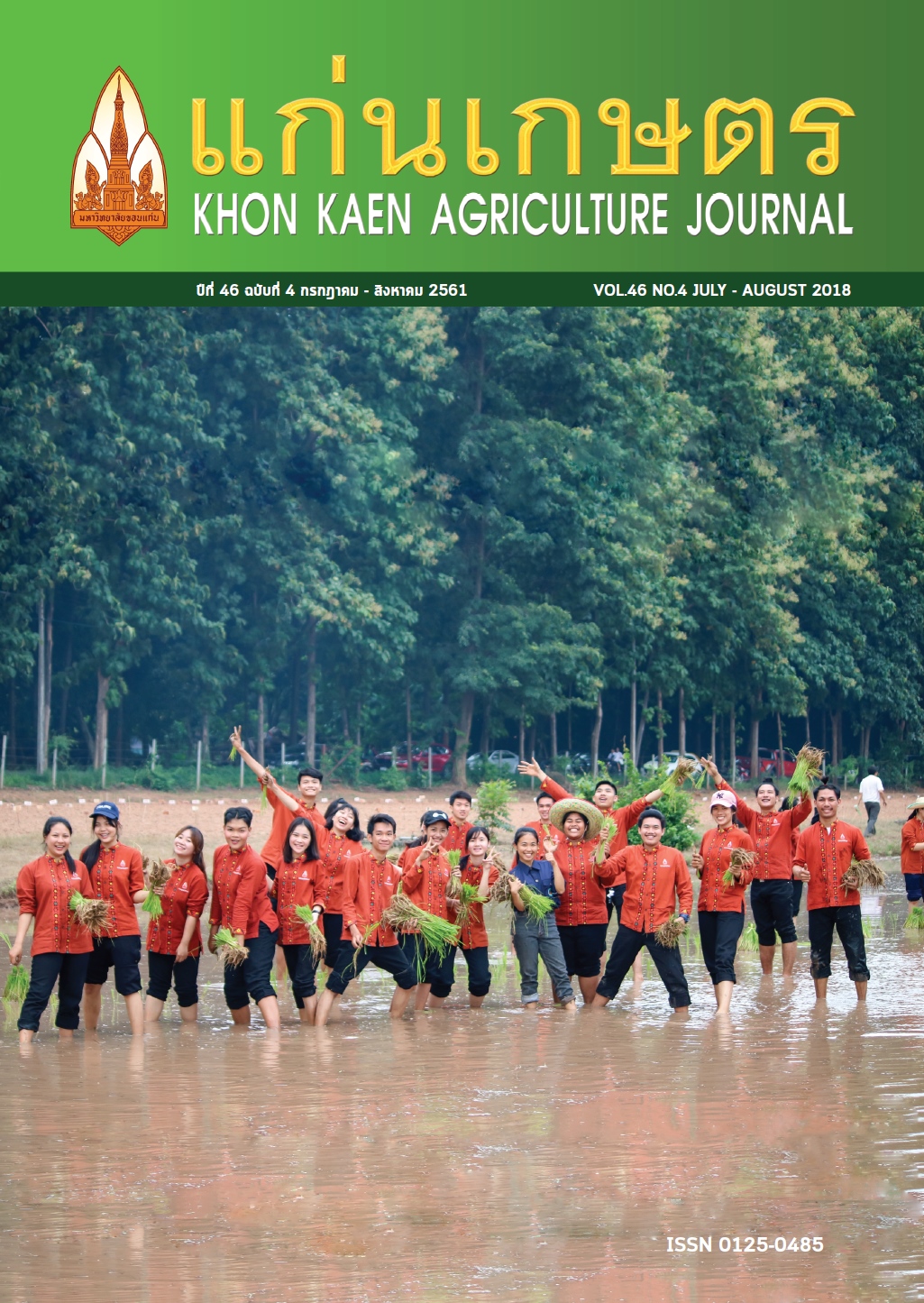การประเมินอินทรียวัตถุที่ย่อยได้ และพลังงานที่ใช้ประโยชน์ได้ของอาหารผสมเสร็จที่ใช้ทางใบปาล์มน้ำมันหมักเชื้อราเป็นแหล่งอาหารหยาบ โดยใช้เทคนิคผลผลิตแก๊ส
Main Article Content
บทคัดย่อ
การศึกษาครั้งนี้มีวัตถุประสงค์เพื่อประเมินปริมาณอินทรียวัตถุที่ย่อยได้และพลังงานที่ใช้ประโยชน์ได้ของอาหารผสมเสร็จ (TMR) ที่ใช้ทางใบปาล์มน้ำมันหมักเชื้อรา (Lentinus sajor-caju, LSc) ทดแทนทางใบปาล์มน้ำมัน 4 ระดับ คือ 0, 33, 67 และ 100% โดยใช้ของเหลวจากกระเพาะรูเมนของโคนมลูกผสมโฮสไตล์ฟรีเชียน 50% เพศผู้ จำนวน 2 ตัว น้ำาหนักเฉลี่ย 450±0.6 kg วางแผนการทดลองแบบสุ่มสมบูรณ์ (Completely Randomized Design) ทำการศึกษาโดยใช้เทคนิคผลผลิตแก๊ส จากการศึกษา พบว่า จลศาสตร์การผลิตแก๊สของอาหารผสมเสร็จที่มีระดับทางใบปาล์มน้ำมันหมักเชื้อราทดแทนทางใบปาล์มน้ำมันที่ระดับ 100% มีค่าปริมาณแก๊สที่เกิดขึ้นจากการย่อยสลายขององค์ประกอบที่สามารถละลายน้ำได้ (a) (-2.92 ml) สูงกว่าอาหารผสมเสร็จที่มีระดับทางใบปาล์มน้ำมันหมักเชื้อราทดแทนทางใบปาล์มน้ำมันที่ระดับ 0% (0.54 ml) อย่างมีนัยสำคัญทางสถิติ (P < 0.05) อย่างไรก็ตาม พบว่า อาหารผสมเสร็จทุกกลุ่มมีค่าศักยภาพในการย่อยสลายของอาหาร (b) ค่าอัตราการผลิตแก๊สโดยเฉลี่ยตลอดระยะเวลาการหมักของอาหาร (c) และค่าศักยภาพในการผลิตแก๊สของอาหาร (d) ไม่แตกต่างกันทางสถิติ (P > 0.05) เช่นเดียวกับปริมาณอินทรียวัตถุที่ย่อยได้ (66.75, 64.72, 67.11 และ 68.71% ตามลำดับ) และพลังงานที่ใช้ประโยชน์ได้ (metabolisable energy ; ME) (2.22, 2.16, 2.23 และ 2.28 เมกกะแคลอรี/กก. วัตถุแห้งตามลำดับ) ของอาหารผสมเสร็จทั้ง 4 สูตร ไม่มีความแตกต่างกัน (P > 0.05) ดังนั้นสามารถใช้ทางใบปาล์มน้ำมันหมักเชื้อราทดแทนทางใบปาล์มน้ำมันได้ถึง 100% ในอาหารผสมเสร็จ
Article Details
เอกสารอ้างอิง
ธีระ เอกสมทราเมษฐ์, ชัยรัตน์ นิลนนท์, ธีระพงศ์ จันทรนิยม ประกิจ ทองคำ และ สมเกียรติ สีสนอง. 2548. การจัดการสวนปาล์มน้ำมัน. น. 51-62. ใน: เส้นทางสู่ความสำเร็จการผลิตปาล์มน้ำมัน. สงขลา: ศูนย์วิจัยและพัฒนา การผลิตปาล์มน้ำมัน คณะทรัพยากรธรรมชาติ มหาวิทยาลัยสงขลานครินทร์, สงขลา.
เมธา วรรณพัฒน์. 2533. โภชนศาสตร์สัตว์เคี้ยวเอื้อง. หจก. ฟันนี่พับบลิชชิ่ง, กรุงเทพฯ.
สุนทร รอดด้วง, ไชยวรรณ วัฒนจันทร์ และ วันวิศาข์ งามผ่องใส. 2554. การประเมินอินทรียวัตถุที่ย่อยได้ และพลังงานที่ใช้ประโยชน์ได้ของอาหารผสมสำเร็จที่ใช้ทางใบปาล์มน้ำมันหมักเป็นแหล่งอาหารหยาบโดยใช้เทคนิคผลผลิตแก๊ส. ว. แก่นเกษตร. 39:251-260.
Adamovic, M., G. Grubic, I. Milenkovic, R. Jovanovic, R. Protic, L. Sretenovic, and L. J. Stoicevic. 1998. The biodegradation of wheat straw by Pleurotus ostreatusmushrooms and its use in cattle feeding. Anim. Feed Sci. Technol. 71:357–362.
Akinfemi, A., and O. A. Ogunwole. 2012. Chemical composition and in vitro digestibility of rice straw treated with Pleurotus ostreatus, Pleurotus pulmonariusand Pleurotus tuber-regium. Slovak J. Anim. Sci. 45:14-20.
AOAC. 1995. Official Methods of Analysis. 16Thed. Assoc. Off. Anal. Chem., Arlington, VA.
Chanjula, P., V. Petcharat, and C. Promkot. 2015. Nutritive value of oil palm frond treated with white rot fungi. P. 135-138. In: Proceedings of the 5th International Conference on Sustainable Animal Agricultural for Developing Countries (5th SAADC 2015), 27-30 October 2015. Chonburi, Thailand.
Fazaeli, H., and A. R. Talebian Masoodi. 2006. Spent wheat straw compost of Agaricus bisporus mushroom as ruminant feed. Asian-Australas. J. Anim. Sci. 6:845-851.
Fazaeli, H., Z. A. Jelan, H. Mahmodzadeh, J. B. Liang, A. Azizi, and A. Osman. 2002. Effect of fungal treated wheat straw on the diet of lactating cows. Asian-Australas. J. Anim. Sci. 11:1573-1578.
Hamed, A. H. M., and M. E. Elimam. 2010. Performance and digestibility in Nubian goats fed stream treated sorghum stover. Pak. J. Nutr. 9:298-301.
Ishida, M., and O. Abu Hassan. 1997. Utilization of oil palm frond as cattle feed. Japan Agric. Res. Quart. 13:41-47.
Kirk, T. K., and K. E. Hammol. 1992. What is the primary agent of lignin degradation in white rot fungi. P.535-540. In: Kuwahara, M. and M. Shimada. Biotechnology in plup and paper industry, Tokyo.
Mahesh M. S., and M. Mohini. 2013. Evaluation of Crinipellis sp. treated wheat straw based diet for ruminants under in vitro system. Indian. J. Anim. Nutr. 32: 25-29.
Menke, K. H., and H .Steingass, 1988. Estimation of energetic feed value obtained from chemical analysis and gas production using rumen fluid. Anim. Res. Dev. 28: 7-55.
Menke, K.H., L. Raab, L. A. Salewski, H. Steingass, D. Fritz, and W. Schneider. 1979. The estimation of the digestibility and metabolizable energy content of ruminant feedstuffs from the gas production when they are incubated with rumen liquor in vitro. J. Agric. Sci. (Camb.). 93: 217-222.
Mertens, D. R. 1997. Creating a system for meeting the fiber requirements of dairy cow. J. Dairy Sci. 80: 1463-1481.
Nasehi, M., N. M. Torbatinejad, S. Zerehdaran, and A. R. Safaie. 2016. Effect of solid-state fermentation by oyster mushroom (Pleurotus florida) on nutritive value of some agro by-products. J. Appl. Anim. Res. 1: 1-6.
NRC. 1981. Nutrient Requirements of Goats: Angora, Dairy and Meat Goats in Temperate and Tropical Countries. Washington, D.C. : National Academy Press.
Okano, K., N. Ohkoshi, A. Nishiyama, T. Usagawa, and M. Kitagawa. 2009. Improving the nutritive value of madake bamboo, Phyllostachys bambusoides, for ruminants by culturing the white rot fungus Ceriporiopsis subvermisspora. Anim. Feed Sci. Technol. 152: 278-285.
Ørskov, E. R., and I. McDonald. 1979. The estimation of protein degradability in the rumen from incubation measurements weighted according to rate of passage. J. Agric. Sci. (Camb.) 92: 499-503.
Rahmana, M. M., M. Lourenco, H. A. Hassim, J. J. P. Baars, A. S. M. Sonnenbergc, J. W. Cone, J. De Boever, and V. Fievez. 2011. Improving ruminal degradability of oil palm fronds using white rot fungi. Anim. Feed Sci. Technol. 169: 157–166.
Rodrigues, M. A. M., P. Pinto, R. M. F. Bezerra, A. A. Dias, C. V. M. Guedes, V. M. G. Cardoso, J. W. Conec, L. M. M. Ferreira , J. Cola and C. A. Sequeira. 2008. Effect of enzyme extracts isolated from white-rot fungi on chemical composition and in vitro digestibility of wheat straw. Anim. Feed Sci. Technol. 14: 326-338.
Sallam, S. M. A., M. E. A. Nasser, A. M. El-Waziry, I. C. S. Bueno, and A. L. Abdalla. 2007. Use of andin vitro rumen gas production technique to evaluate some ruminant feedstuffs. J. Applied Sci. Res. 3: 34-41.
Shrivastava, B., P. Nandal, A. Sharma, K. K. Jain, Y. P. Khasa, T. K. Das, V. Mani, N. J. Kewalramani, S. S. Kundu, and R. C. Kuhad. 2012. Solid state bioconversion of wheat straw into digestible and nutritive ruminant feed by Ganaderma sp. rcckk02. Biores. Technol. 107: 347-357.
Supapong, C., A. Cherdthong, A. Seankamsorn, B. Khonkhaeng, M. Wanapat, S. Uriyapongson, N. Gunun, P. Gunun, P. Chanjula, and S. Polyorach. 2017. In vitro fermentation, digestibility and methane production as influenced by Delonix regia seed meal containing tannins and saponins. J. Anim. Feed Sci. 26: 123-130.
Steel, R. G. D., and J. H. Torrie. 1980. Principles and procedures of statistics: A Biometerial Approach. (The 2nd ed.). McGraw-Hill Book Co, New York.
Tuyen, D. V., H. N. Phuong, J. W. Cone, J. J. P. Baars, A. S. M. Sonnenberg, and W. H. Hendriks. 2013. Effect of fungal treatments of fibrous agricultural by-products on chemical composition and in vitro rumen fermentation and methane production. Biores. Technol. 129: 256–263.
Van Soest, P. J., J. B. Robertson, and B. A. Lewis. 1991. Method for dietary fiber, neutral detergent fiber, and nonstarch polysaccharides in relation to animal nutrition. J. Dairy Sci. 74: 3583-3597.


